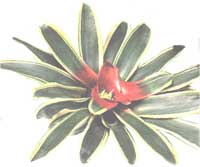Neoregelia / neoregelia
Refers to the family of bromeliads. Fatherland is Brazil.
General description: Neoregelia is an ornamental deciduous plant. Its leaves reach 40 cm in length, it grows widely, so neoregelia is better to grow as if a single plant. Usually in the room conditions the following species are bred:
Neoregelia carolinae (Neoregelia Carolina). The leaves are bright, belt-like, diverge from the basal rosette. In Neoregelia carolinae marechalii they are dark green, in Neoregelia carolinae tricolor striped. Before the flowering, the bases of internal leaves blush in this species. Blossoms with blue flowers.
Neoregelia carolinae spectabilis (neoregelia beautiful). Before flowering, it does not blush in any way the grounds, only the tips of the leaves.
The plant is rather unpretentious, easily bred in indoor conditions.
Recommendations for plant care Neoregelia:
Illumination : photophilous, shading is needed only in the summer noon.
Irrigation regime : Abundant during the growth period, moderate in winter. To water with warm soft water. It is recommended to pour water directly into the outlet, but only in summer, in winter it is better to soil, in order to avoid decay.
Humidity : Requires periodic spraying. Loves a fresh atmosphere, but without drafts.
Temperature regime : In summer, the temperature should be moderate 22-25 ° C, in the winter cool 16-20 ° C, at least 13 ° C.
Soil : Very good bore is required. You can add charcoal and coniferous bark.
Recommended soil mixture: 1 share of light turf ground, 1 share leafy, 1 share peat, 1 share humus and 1/2 part sand. You can use a purchased soil mix for orchids.
During the growth period, one needs to fertilize once a month with complex fertilizers for bromeliads or conventional ones in half. Diluted fertilizer is applied for irrigation or a spray route.
Breeding : The shoots that form at the base of the plant are usually rooted in soil heating. You can sow seeds, but they must be etched and sterilized beforehand. The soil for germination must be very loose (a mixture of leafy soil and sand or chopped moss and fern roots). Seedlings need high humidity, shading and soil heating.
Transplantation : The maternal plant dies after flowering. In the spring, the offspring are transplanted. The root system is shallow, the pots shall be shallow.
Pests : It is affected by scarlet spider mites (in a dry atmosphere, leaves and stems are braided with cobwebs), mealybug, scabbards (brown plaques appear on leaves and stems, leaving sticky discharge), aphids.
With a slight infection, the plant is allowed to help finish with a soap solution and a warm wash.
In case of severe damage, spraying with an insecticide solution (acticle, decis, phytoverm etc.) is recommended.

Neoregelia - neoregelia


Comments
When commenting on, remember that the content and tone of your message can hurt the feelings of real people, show respect and tolerance to your interlocutors even if you do not share their opinion, your behavior in the conditions of freedom of expression and anonymity provided by the Internet, changes Not only virtual, but also the real world. All comments are hidden from the index, spam is controlled.